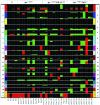Aneuploidy arises at early stages of Apc-driven intestinal tumorigenesis and pinpoints conserved chromosomal loci of allelic imbalance between mouse and human
- PMID: 17200209
- PMCID: PMC1762685
- DOI: 10.2353/ajpath.2007.060853
Aneuploidy arises at early stages of Apc-driven intestinal tumorigenesis and pinpoints conserved chromosomal loci of allelic imbalance between mouse and human
Abstract
Although chromosomal instability characterizes the majority of human colorectal cancers, the contribution of genes such as adenomatous polyposis coli (APC), KRAS, and p53 to this form of genetic instability is still under debate. Here, we have assessed chromosomal imbalances in tumors from mouse models of intestinal cancer, namely Apc(+/1638N), Apc(+/1638N)/KRAS(V12G), and Apc(+/1638N)/Tp53-/-, by array comparative genomic hybridization. All intestinal adenomas from Apc(+/1638N) mice displayed chromosomal alterations, thus confirming the presence of a chromosomal instability defect at early stages of the adenoma-carcinoma sequence. Moreover, loss of the Tp53 tumor suppressor gene, but not KRAS oncogenic activation, results in an increase of gains and losses of whole chromosomes in the Apc-mutant genetic background. Comparative analysis of the overall genomic alterations found in mouse intestinal tumors allowed us to identify a subset of loci syntenic with human chromosomal regions (eg, 1p34-p36, 12q24, 9q34, and 22q) frequently gained or lost in familial adenomas and sporadic colorectal cancers. The latter indicate that, during intestinal tumor development, the genetic mechanisms and the underlying functional defects are conserved across species. Hence, our array comparative genomic hybridization analysis of Apc-mutant intestinal tumors allows the definition of minimal aneuploidy regions conserved between mouse and human and likely to encompass rate-limiting genes for intestinal tumor initiation and progression.
Figures



Similar articles
-
Chromosomal instability and APC gene mutations in human sporadic colorectal adenomas.J Pathol. 2004 Oct;204(2):193-9. doi: 10.1002/path.1623. J Pathol. 2004. PMID: 15376262
-
APC inactivation associates with abnormal mitosis completion and concomitant BUB1B/MAD2L1 up-regulation.Gastroenterology. 2007 Jun;132(7):2448-58. doi: 10.1053/j.gastro.2007.03.027. Epub 2007 Mar 19. Gastroenterology. 2007. PMID: 17570218
-
APC and oncogenic KRAS are synergistic in enhancing Wnt signaling in intestinal tumor formation and progression.Gastroenterology. 2006 Oct;131(4):1096-109. doi: 10.1053/j.gastro.2006.08.011. Epub 2006 Aug 16. Gastroenterology. 2006. PMID: 17030180
-
Emergent issues in the genetics of intestinal neoplasia.Cancer Surv. 1995;25:335-55. Cancer Surv. 1995. PMID: 8718526 Review.
-
The intestinal epithelium and its neoplasms: genetic, cellular and tissue interactions.Philos Trans R Soc Lond B Biol Sci. 1998 Jun 29;353(1370):915-23. doi: 10.1098/rstb.1998.0256. Philos Trans R Soc Lond B Biol Sci. 1998. PMID: 9684289 Free PMC article. Review.
Cited by
-
Tumor suppressor genes in familial adenomatous polyposis.Gastroenterol Hepatol Bed Bench. 2017 Winter;10(1):3-13. Gastroenterol Hepatol Bed Bench. 2017. PMID: 28331559 Free PMC article. Review.
-
Insertional mutagenesis identifies multiple networks of cooperating genes driving intestinal tumorigenesis.Nat Genet. 2011 Nov 6;43(12):1202-9. doi: 10.1038/ng.990. Nat Genet. 2011. PMID: 22057237 Free PMC article.
-
Long-lived Min mice develop advanced intestinal cancers through a genetically conservative pathway.Cancer Res. 2009 Jul 15;69(14):5768-75. doi: 10.1158/0008-5472.CAN-09-0446. Epub 2009 Jul 7. Cancer Res. 2009. PMID: 19584276 Free PMC article.
-
Molecular cartography uncovers evolutionary and microenvironmental dynamics in sporadic colorectal tumors.Cell. 2023 Dec 7;186(25):5620-5637.e16. doi: 10.1016/j.cell.2023.11.006. Cell. 2023. PMID: 38065082 Free PMC article.
-
Adenomatous polyposis coli in cancer and therapeutic implications.Oncol Rev. 2021 Jun 24;15(1):534. doi: 10.4081/oncol.2021.534. eCollection 2021 Feb 26. Oncol Rev. 2021. PMID: 34267890 Free PMC article.
References
-
- Fodde R, Smits R, Clevers H. APC, signal transduction and genetic instability in colorectal cancer. Nat Rev Cancer. 2001;1:55–67. - PubMed
-
- Cardoso J, Molenaar L, de Menezes RX, van Leerdam M, Rosenberg C, Moslein G, Sampson J, Morreau H, Boer JM, Fodde R. Chromosomal instability in MYH- and APC-mutant adenomatous polyps. Cancer Res. 2006;66:2514–2519. - PubMed
-
- Cahill DP, Lengauer C, Yu J, Riggins GJ, Willson JK, Markowitz SD, Kinzler KW, Vogelstein B. Mutations of mitotic checkpoint genes in human cancers. Nature. 1998;392:300–303. - PubMed
-
- Shichiri M, Yoshinaga K, Hisatomi H, Sugihara K, Hirata Y. Genetic and epigenetic inactivation of mitotic checkpoint genes hBUB1 and hBUBR1 and their relationship to survival. Cancer Res. 2002;62:13–17. - PubMed
-
- Rajagopalan H, Jallepalli PV, Rago C, Velculescu VE, Kinzler KW, Vogelstein B, Lengauer C. Inactivation of hCDC4 can cause chromosomal instability. Nature. 2004;428:77–81. - PubMed
Publication types
MeSH terms
Substances
LinkOut - more resources
Full Text Sources
Molecular Biology Databases
Research Materials
Miscellaneous

